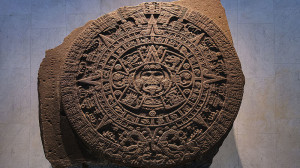Creation Corner
Energy to change a calendar

On July 7, the National Creationism Examiner discussed the history of the calendar. At issue: the ancient Egyptians, of all people, had the best natural season indicator: the Nile flood season. Why, then, did they keep a 360-day calendar for centuries? The natural calendar of the earth changed. The Egyptians took time to readjust their official calendar, but they did, beginning with the Twelfth Dynasty (Amenamhāt I, the “Pharaoh who did not know Joseph.”)
But how did this happen?
Calendar change events

Aztec calendar stone, National Museum of Archaeology, Mexico City. Photo: Sasha Isachenko on Wikimedia Commons, CC BY-SA 3.0 Unported License.
Two things happened to change the calendar:
- The day on Earth grew shorter. Gravitational settling after the Global Flood shortened the day by more than twenty minutes.
- The month also grew shorter. Seven impactors, most of them striking on the same hemisphere, lessened the moon’s specific energy. This dropped the moon into a lower orbit, with a shorter period. Today a lunar month is only slightly longer than twenty-nine-and-one-half days. And these are today’s shorter days, not the twenty-minutes-longer days before the Flood.
After the Examiner published that article, a reader contacted him to dispute the theory. He held the earth simply did not generate nearly enough energy to expel not only the material that became the seven impactors, but also the material that became the other asteroids, meteoroids, comets, and even Trans-Neptunian Objects. He wrote:
Sooo…
The Earth expels up to 4% of its mass (no mention made here of the effect on the Moon’s orbit of this mass loss, but it should jump to a higher orbit) and then at some later date seven impactors strike the Moon on the same hemisphere, slowing it and driving it into a still-higher orbit. Correct so far?
It would be interesting to see a back-of-the-envelope calculation showing the energy budget for such a series of events.
Actually, the impactors must drop the moon to a lower orbit, not a higher. But one may still ask: has anyone calculated the energy budget for launching so much matter from earth? Not to fear. Walter T. Brown, originator of the Hydroplate Theory, did.
Calendar energy budget
Dr. Brown placed his calculation here, as an end-note to a wider discussion of the vast energies the Global Flood released. Why does this discussion appear in a chapter describing the origins of radioactivity on earth? Because much of the energy the Flood released, went into forming those radioactive elements. That in turn released energy from the thermalization of neutrons. (Thermalization is the slowing of free neutrons, or other subatomic particles, to the prevailing speeds of similar particles at the local temperature of the medium.) That process supplied the energy to launch into space the material for the impactors, and many other objects besides.
Brown writes:
Our oceans have 1.43 × 1024 grams of water. For every 18 grams of water (1 mole) there are 6.022 × 1023 (Avogadro’s number) water molecules—each with 2 hydrogen atoms. One out of every 6,400 hydrogen atoms in our oceans is heavy hydrogen (2H or deuterium). Each fast neutron thermalized by water produced at least 1 MeV of heat energy. (1 MeV = 1.602 × 10-6 erg) A hydrogen atom (1H) that absorbs a fast neutron releases 2.225 MeV of binding energy and becomes deuterium. So, assuming earth had no unusual amount of deuterium before the flood, the amount of nuclear energy that was added to the subterranean water over several weeks, just in forming deuterium, was:
( 1.43 × 1024/18) × (6.022 × 1023/6400) × 2 × (1 + 2.225) × 1.602 × 10-6 = 7.72 × 1037 ergs
Which is equivalent to 1.8 quadrillion one-megaton thermonuclear bombs. Any process releasing that much energy in one spot would melt the earth with it.
This is merely the energy for forming heavy hydrogen in the ocean. And: it is comparable to the energy of the launch of the material that became the Mavericks of the Solar System.
Brown lists that energy budget here. He shows elsewhere in his work that the cometary material must have launched at 32 km/s on average. The rest of the material could have launched at escape speed, which is 11.2 km/s. Total energy required: 1.1 × 1038 ergs. Brown generously doubles that, to allow for fifty-percent efficiency in the launching.
Calendar energy supply
Where did all that energy, plus the energy to release all those neutrons, come from? Brown cites at least four sources:
- Tidal pumping over at least 1,656 years, that made the sub-crustal waters supercritically hot,
- Fire in the sub-crustal chamber, producing many of the earth’s ores,
- The potential energy of the crust pressing down on that sub-crustal ocean, and
- Nuclear energy. The release of this last begins with the high piezoelectric voltages from the magnitude-10-to-12 earthquakes on the continental land masses.
Of these, the nuclear energy source is the most abundant, by four orders of magnitude. Recall that 7.72 × 1037 ergs was available from deuterium production alone. The rest likely came from super-heavy elements that decayed to produce the trans-lead elements and other radioactive isotopes of lighter-than-lead elements (including 14C) we see in the earth’s crust, atmosphere, and seas. This includes tritium (3H), the radioactive isotope of hydrogen, and other heavy isotopes of lighter-than-lead elements, radioactive or not.
Furthermore, the calculation for the thermalization energy from deuterium production uses the water now in the oceans. It does not account for the water that was expelled. Samples of cometary ice have already shown it has twice the concentration of deuterium in the earth’s oceans. So the nuclear energy from deuterium production would be slightly greater.
To sum up: changing the calendar of earth took energy, and a lot of it. But earth had that energy, locked up and ready for release. That release came with the Global Flood, as one effect that proves most difficult for modern human beings to understand.
Reprinted from examiner.com
[subscribe2]
Terry A. Hurlbut has been a student of politics, philosophy, and science for more than 35 years. He is a graduate of Yale College and has served as a physician-level laboratory administrator in a 250-bed community hospital. He also is a serious student of the Bible, is conversant in its two primary original languages, and has followed the creation-science movement closely since 1993.
-

 Civilization5 days ago
Civilization5 days agoIlhan Omar Did Not Flee From Oppression As A Refugee – She Was Fleeing Justice & Has Been Installed To Attack – This Video Speaks Loud & Clear
-

 Guest Columns4 days ago
Guest Columns4 days agoShe Saved Her Life. 7-Eleven Fired Her
-

 Civilization5 days ago
Civilization5 days agoThis Thanksgiving, Celebrate the New Beacon of the American Dream
-

 Civilization4 days ago
Civilization4 days agoDemocrats’ Viral Video Lights Match to the Republic
-

 Guest Columns3 days ago
Guest Columns3 days agoWaste of the Day: What’s Big, Grey And Costs $350K?
-

 Civilization3 days ago
Civilization3 days agoThe AI Challenge: Palantir, the Pope, and Paul Kingsnorth
-

 Civilization3 days ago
Civilization3 days agoNo Kings, No Queens, No Blind Loyalty
-

 Executive2 days ago
Executive2 days agoWaste of the Day: California’s $450 Million 911 Center Doesn’t Work













If this was meant to be in response to my earlier posts, while I appreciate the effort, it does not address the questions that I raised. I was wondering whether any work had been done to show the energy budget for slowing down the Moon and, yes, dropping it into a lower orbit – not for the energy budget of the Flood itself.
Regardless of how much energy Dr. Brown’s theory requires to launch the 2% or 4% of Earth’s mass in the first place, or from what sources that energy was derived, or where exactly the energy went, it remains that to drop the Moon into a lower orbit requires a significant delta-v. To claim that this delta-v (which is in principle calculable if you make your starting assumptions clear, as I tried to do in my earlier post) was accomplished via _seven impacts_ would suggest that some behind-the-scenes work has been done to confirm that this is physically possible. Otherwise it’s just a blue-sky claim that relies entirely on Dr. Brown’s authority. I tried to demonstrate that to do this job with seven impactors would require that they either be extremely massive (larger than the largest asteroids in the Solar System) or traveling at extreme speeds (flirting with relatavistic effects). Either way, the energy deposited into the Moon would be something between gargantuan and apocalyptic. The Moon, if it survived, would look nothing like what we see today if these events took place within the last ten thousand years. Nor would the Earth, for that matter.
Rather than address that set of issues, you have linked to Dr. Brown’s account of the energy released during the Flood from a variety of theoretical sources. It seems that my earlier prediction still holds true: you haven’t asked Dr. Brown about calculations that show how the Moon’s rotation and orbit could have been changed by collisions with seven impactors (or with however many you specify) from a given primordial orbit of 30 days to the current one, and he hasn’t volunteered any such calculations. I do not believe that such calculations exist, and that the claim relies completely on argumentum ab auctoritate.
[…] from examiner.com and Conservative News and […]
[…] Energy to change a calendar […]